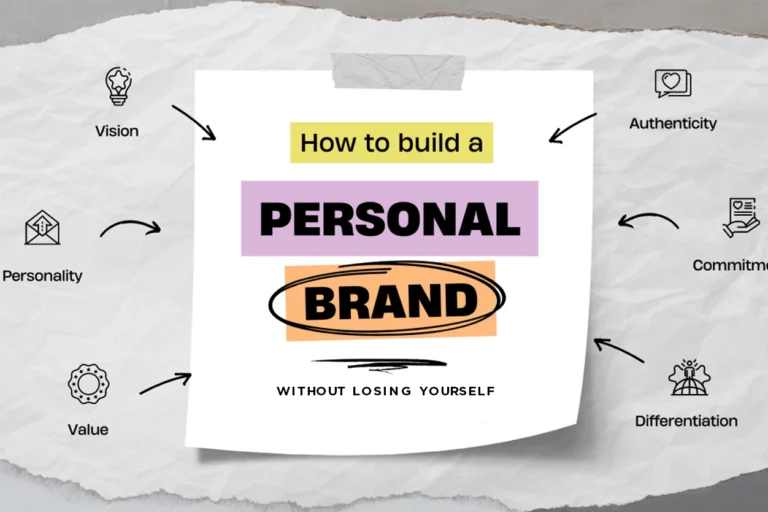Introduction
You’re posting on LinkedIn when you can, tinkering with Canva templates, polishing pitch decks that never feel finished… and yet, your brand still feels like something is missing. You’re doing everything right but your audience is still unsure who you are, what you do, or why they should trust you.
That’s the real pitfall to a weak personal brand: not invisibility, but inconsistency and inauthenticity. When your brand shows up in fragments, it undermines the very credibility you’re trying to build.
A strong personal brand doesn’t start with content. It starts with foundations.
In this blog, we’ll walk through the 8 essential elements that create those foundations: values, audience, story, proof, visibility, presence, voice, and visuals. Each section explains why it matters and how to draft it the right way.
And if you’re ready to put this into practice, the 5-Hour Personal Brand Foundation Workbook will help you map it all in one focused session so you can stop spinning your wheels and start compounding your influence.
Values & Vision – Your Brand’s Compass
Every strong personal brand starts with clarity, not content. Before you design a logo, record a video, or write a single LinkedIn post, you need to know what you stand for. That’s where values and vision come in: the compass that keeps your brand aligned even when the path feels chaotic.
“Fake Personas collapse under their own weight.” Attempting to maintain a polished but hollow image is immediately obvious, and absolutely unsustainable in the long run. Genuine expression, even when imperfect, resonates because it feels human.
Why Values Matter
Your values are the filter through which every brand decision is made. They determine what you say yes to, what you decline, and how you show up for your audience. Without them, your brand risks becoming reactive, posting whatever is trending, chasing likes instead of building credibility.
Research in Frontiers in Psychology shows that personal branding is most effective when it grows out of identity (your values, beliefs, and long-term goals) rather than surface-level tactics. In other words: if your brand doesn’t start from who you are, it won’t be sustainable.
Think of values as the DNA of your brand. For some founders, that might mean empowerment, transparency, or curiosity. For others, it might be precision, creativity, or growth. The important part isn’t which values you choose, it’s that you choose deliberately and live them consistently.
Why Vision Matters
If values are the compass, vision is the destination. A personal brand without vision is like a journey without a map: you’ll keep moving, but you’ll never know if you’re getting closer to what you want.
Vision answers the question: Where is this brand taking me? Maybe it’s to become a recognized thought leader in your industry. Maybe it’s to attract investor attention for your startup. Maybe it’s to build credibility so you can write the book, land the speaking gigs, or mentor the next generation. Whatever the outcome, vision provides focus and focus saves energy.
Drafting Vision and Values the Right Way
It’s easy to fall into the trap of treating values and vision as vague statements: something you write once and forget. But when done right, they serve as your north star for every piece of content and every brand decision.
The vague way: “I’ll commit to share content for founders.”
The intentional way: “I commit to sharing content that reflects my three values: empowerment, clarity, and growth. My vision is to become a trusted voice for early-stage founders in the UK.”
The vague version sounds broad and directionless, while the intentional version provides clarity and focus.
The Bottom Line
When you define your values and vision, your brand stops being a performance and starts being a practice. They become the lens through which you decide what to share, what to save, and how to stay aligned. Without them, it’s too easy to drift into inauthenticity or burn out chasing every trend.
Audience & Positioning – Who You Serve & Why You Stand Out
A personal brand without a defined audience is like shouting into a crowded room. You might make noise, but you won’t be remembered. For solo founders especially, clarity on who you serve and why you’re different saves you from wasted effort and generic messaging.
Why Audience Matters
Not everyone is your customer and that’s a good thing. When you try to appeal to everyone, your message becomes so diluted that it resonates with no one. Narrowing your audience allows you to speak directly to the people who need your expertise most.
Brand strategist Jay Baer points out that personal branding isn’t about instant clarity; it’s about patience and focus. The clearer you are on who you serve, the easier it is to build trust over time.
Why Positioning Matters
Audience clarity tells you who you serve, but positioning tells you why you’re the best fit. It answers the questions:
Without positioning, you risk blending into a sea of sameness. With it, you stand out as the obvious choice.
Drafting Audience and Positioning the Right Way
The trap many founders fall into is defining their audience too broadly and leaning on vague positioning statements. The fix is to describe your ideal audience with precision and communicate how you uniquely solve their problem.
The vague way: “My audience is anyone who needs help with branding.”
The intentional way: “I help early-stage coaches who feel overwhelmed by DIY branding build a clear story that attracts clients and opportunities.”
The vague version sounds unfocused and generic. The intentional version makes it easy for the right people to recognize themselves in your message. Niche down and really pinpoint the kind of people you’d like to work with.
The Bottom Line
Audience and positioning are the filter that sharpen your personal brand. When you know who you’re speaking to and why you’re the right choice; you move from shouting into the void to having a direct, meaningful conversation with the people who matter most.
Messaging & Story – The Narrative People Remember
When someone comes across your name online, what do you want them to remember? That’s the role of your messaging and story: to make your brand memorable, repeatable, and unmistakably yours.
Why Messaging Matters
Your messaging is the shortcut to how people describe you when you’re not in the room. A clear one-liner makes it easier for others to repeat your value back to you. Without it, you risk being known as “someone who does a bit of everything,” which dilutes credibility.
Research from the Elite CISOs Personal Branding Workshop stresses that your story should be built in layers: your identity, your zone of genius, and your client’s needs. Together, they form a message that not only introduces you but also positions you as the solution your audience is searching for.
Why Story Matters
Humans don’t remember data; they remember stories. A founder who can share their “spark → struggle → shift → solution” journey creates a narrative arc that resonates more deeply than a list of services. Studies in psychology confirm this: shared experiences, especially struggles, are more memorable and foster empathy.
Your story isn’t about making yourself the hero. It’s about showing your audience the transformation they can expect when they work with you.
Drafting Messaging and Story the Right Way
It’s tempting to describe yourself with broad, vague language or to overload your message with everything you can do. But clarity and consistency are what turn a story into a brand asset.
The vague way: “I’m a trainer who helps people get fit.”
The intentional way: “I help low BMI people gain weight healthily through balanced diet and strength training.”
The vague version is forgettable. The intentional version is precise, memorable, and easy to repeat.
The Bottom Line
Your messaging and story are the backbone of your brand. A clear one-liner and a simple story framework give your audience the language to talk about you, recommend you, and remember you. When your message is simple and your story is human, your brand becomes sticky.
Proof & Credibility – Show, Don’t Just Tell
A strong personal brand isn’t built on promises alone. People don’t just want to hear what you say you can do, they want evidence that you can actually deliver. That’s where proof and credibility come in.
Why Proof Matters
In a noisy digital world, credibility is currency. Anyone can claim expertise, but proof separates the professionals from the pretenders. Testimonials, case studies, and real-world results show that your brand delivers on its promises.
Research backs this up: a survey by Vestbee found that 87% of investors consider the founder’s personal brand a key factor in funding decisions. The main takeaway of this survey was that people back brands they trust built on evidence.
Why Credibility Matters
Credibility doesn’t just influence investors. It reassures potential clients, partners, and collaborators that they’re making the right choice. Proof signals reliability, and reliability compounds into reputation. A strong reputation then becomes your most powerful marketing tool.
Proof also strengthens your message. Without it, even the clearest one-liner risks sounding like empty marketing. With it, your story becomes believable and actionable.
Drafting Proof and Credibility the Right Way
It’s easy to rely on vague claims or broad statements, but they rarely inspire confidence. The stronger approach is to tie your brand promise to measurable results, specific examples, or credible social proof.
The vague way: “Trust me, I’m experienced.”
The intentional way: “Last quarter, I helped 3 authors self-publish and sell out over 2000 copies of their books.”
The vague version could apply to anyone. The intentional version demonstrates skill, impact, and a concrete outcome.
The Bottom Line
Proof turns branding from words into reality. Whether it’s testimonials, before-and-after results, or even small wins documented in public, credibility reinforces your brand promise. Show, don’t just tell and your personal brand becomes a reputation people can trust.
Content Pillars & Visibility – Consistency Beats Inspiration
For many solo founders, visibility feels like a guessing game. You sit down to post, stare at the blinking cursor, and wait for inspiration to strike. What you end up creating is sporadic posting, inconsistent messaging, and an audience that struggles to understand what you actually stand for.
Why Content Pillars Matter
Content pillars give structure to your brand presence. They are 3–4 themes that you return to consistently, ensuring your audience knows exactly what to expect from you. Instead of spreading yourself thin across random topics, you focus on the areas that reinforce your expertise and values.
Research from The Guardian highlights that the best personal brands aren’t built on viral stunts; they’re cultivated steadily and deliberately. By sticking to defined pillars, you create a drumbeat of clarity, rather than random bursts of noise.
Why Visibility Matters
Visibility isn’t about being everywhere, it’s about showing up where it matters, with content that compounds over time. Every post adds a layer to your brand’s reputation. Without visibility, even the clearest values, message, and proof remain hidden.
Consistent visibility does two things:
Drafting Content and Visibility the Right Way
The mistake most founders make is either posting without a plan or vanishing when inspiration dries up. The right approach is to define content pillars, then show up regularly with posts tied to those themes.
The vague way: “I’ll post when I feel inspired.”
The intentional way: “My three pillars are: teaching frameworks, sharing my founder journey, and proof-based posts. Each week, I rotate between them so my content stays consistent and recognizable.”
The vague version leads to burnout and confusion. The intentional version creates rhythm and builds audience trust.
The Bottom Line
Content pillars turn visibility from chaos into strategy. By choosing a handful of themes that align with your values and audience, you remove decision fatigue, build consistency, and strengthen your brand identity. Over time, visibility rooted in clarity becomes the engine of your credibility.
Professional Presence – Profiles & First Impressions
Your online profile is often the first, and sometimes the only impression your audience gets of you. Before they book a call, read a blog, or attend your workshop, they’ve already scanned your LinkedIn headline, your profile photo, and maybe your featured section. That first glance can either build credibility or quietly undermine it.
Why Professional Presence Matters
Research shows that people form impressions of trust and competence within seconds of seeing a profile. According to image consultant Zayna Rose (Business Insider), aligning authentic self-expression with polished presence creates confidence and credibility. In other words: being real matters, but so does how you present yourself.
For solo founders, this is especially critical. Your profile isn’t just about you, it’s your storefront, your pitch deck, and your brand billboard all in one. A sloppy profile sends the wrong signal; a cohesive one builds instant trust.
What Professional Presence Includes
Drafting Professional Presence the Right Way
It’s tempting to throw something together and assume “content will speak for itself.” But in reality, your profile frames how your content is received.
The vague way: Grainy selfie photo, generic banner, and a headline like “Consultant | Coach | Speaker.”
The intentional way: Professional headshot, clean banner with your brand promise, and a headline like “I help early-stage founders clarify their brand story so they attract the right opportunities without burnout.”
The vague version is forgettable. The intentional version is clear, credible, and makes it easy for someone to know whether you’re the right fit.
The Bottom Line
Professional presence is about being clear, consistent, and credible at first glance. When your profiles align with your values, story, and proof, they become more than placeholders. They become silent ambassadors, opening doors before you ever step into the room.
Brand Voice – The Personality in Your Words
Your personal brand doesn’t just live in visuals or logos: it lives in how you communicate. Every post, email, and message carries a “voice,” and that voice becomes part of your identity. Get it right, and your words make you instantly recognizable. Get it wrong, and you’ll sound inconsistent or, worse, forgettable.
Why Brand Voice Matters
Research published in the Journal of Business Research shows that a consistent voice across touchpoints increases both trust and brand recognition. Inconsistent tone, on the other hand, confuses your audience and weakens credibility.
For solo founders, brand voice is especially powerful. You don’t have a big marketing team: you are the voice. The way you show up in words shapes how people feel about you before they ever meet you.
Defining Your Brand Voice
Your brand voice should reflect:
Drafting Brand Voice the Right Way
The mistake most founders make is letting tone shift wildly depending on the platform or mood. The right approach is to define a voice that feels true to you and stick to it consistently.
The vague way: One day writing a stiff, corporate-sounding post, the next day dropping casual slang, and the day after that sharing jargon-heavy articles.
The intentional way: “My brand voice is clear, approachable, and empowering. Every post is written to make complex ideas simple, to sound like advice from a trusted peer, and to leave the reader with confidence.”
The vague version feels inconsistent and forgettable. The intentional version builds familiarity and trust because it’s predictable and recognizable.
The Bottom Line
Brand voice is the personality of your communication. When you define it clearly and use it consistently, you stop sounding like just another founder with something to say. Instead, you sound like you every time. And that familiarity is what makes people listen, remember, and return.
Color Identity – Visual Cues That Stick
Long before people read your posts or hear your pitch, they notice your visuals. Color is often the first impression and one of the strongest anchors for memory. The right color identity makes your brand instantly recognizable, while random or inconsistent colors leave you looking scattered.
Why Color Identity Matters
Research from Loyola University found that color increases brand recognition by up to 80%. That means the palette you choose is strategic, and not just for the aesthetics.
Color psychology also shows that different hues trigger different associations:
Blue → trust, stability, professionalism
Green → growth, health, balance
Red → urgency, passion, boldness
Yellow → optimism, creativity, energy
For solo founders, a consistent color palette creates visual cohesion across slides, social posts, websites, and lead magnets. It makes even DIY design look professional and intentional.
Defining Your Color Identity
A simple, effective brand palette usually includes:
This 60/30/10 balance ensures your brand feels cohesive without being overwhelming.
Drafting Color Identity the Right Way
The common mistake is picking random Canva templates each time, leading to a scattered, inconsistent brand presence. The right approach is to define and stick to a palette that reflects your values and desired perception.
The vague way: Every LinkedIn post uses a different Canva template with clashing palettes.
The intentional way: “My brand uses deep blue (trust) as primary, gray (neutral) as secondary, and green (growth) as accent. These colors appear on my profile banner, slides, and posts so my content feels instantly recognizable.”
The vague version feels chaotic and forgettable. The intentional version builds recognition and trust every time your audience sees your content.
The Bottom Line
Color identity is about memory, emotion, and trust. With a simple, consistent palette, your brand looks polished, feels professional, and becomes far easier to recognize in a crowded feed. For founders, that visual consistency is often the difference between being overlooked and being remembered.
Conclusion – Building on Solid Ground
For solo founders, building a personal brand can feel like juggling chaos: half-done decks, scattered tools, and endless tabs. But as we’ve seen, real brand power doesn’t come from tools, rather it comes from foundations.
When you invest the time to define your:
…you stop spinning your wheels and start compounding your influence.
The wrong way is to treat branding as a set of scattered tasks, jumping between Canva templates, unfinished posts, and inconsistent profiles. The right way is to build on a foundation of clarity, consistency, and credibility.
Because branding isn’t about doing more. It’s about doing the right things, repeatedly.
Ready to put this into practice?
Download the 5-Hour Personal Brand Foundation Workbook and map out your own brand step by step. Your future audience, investors, and collaborators will thank you.






